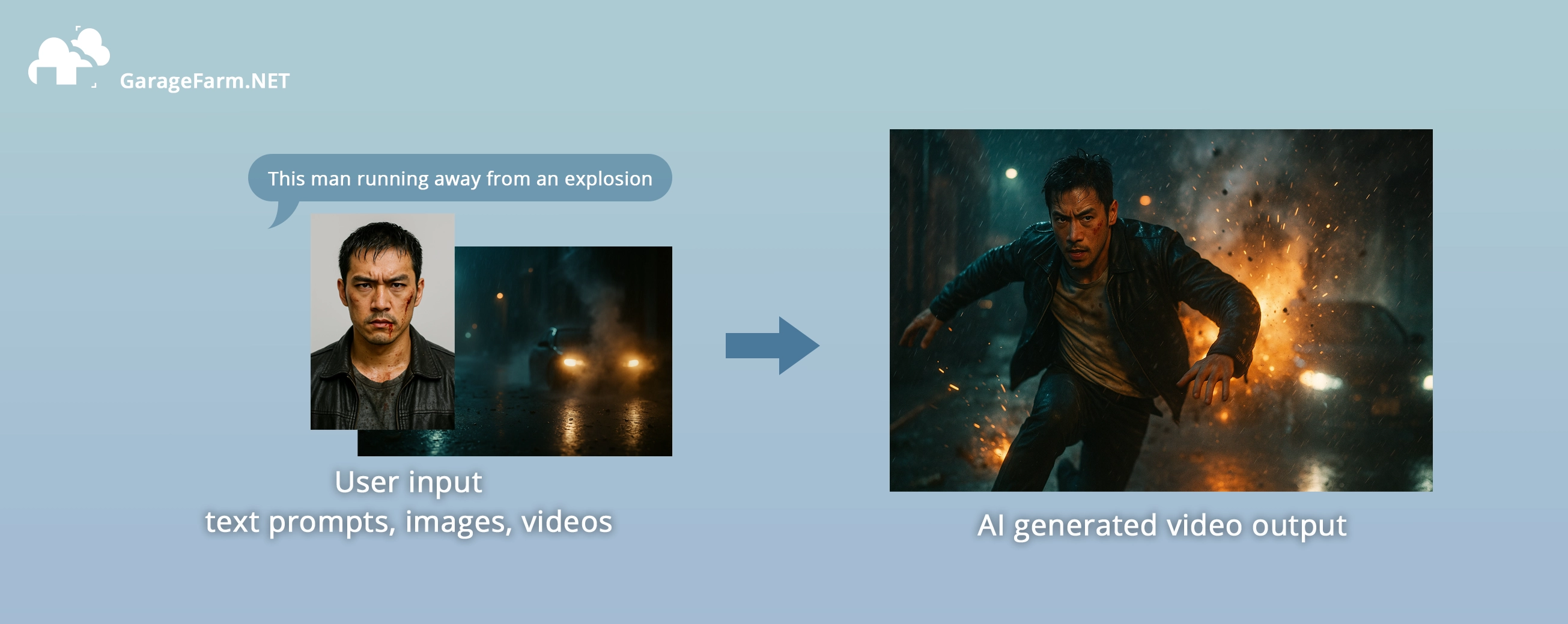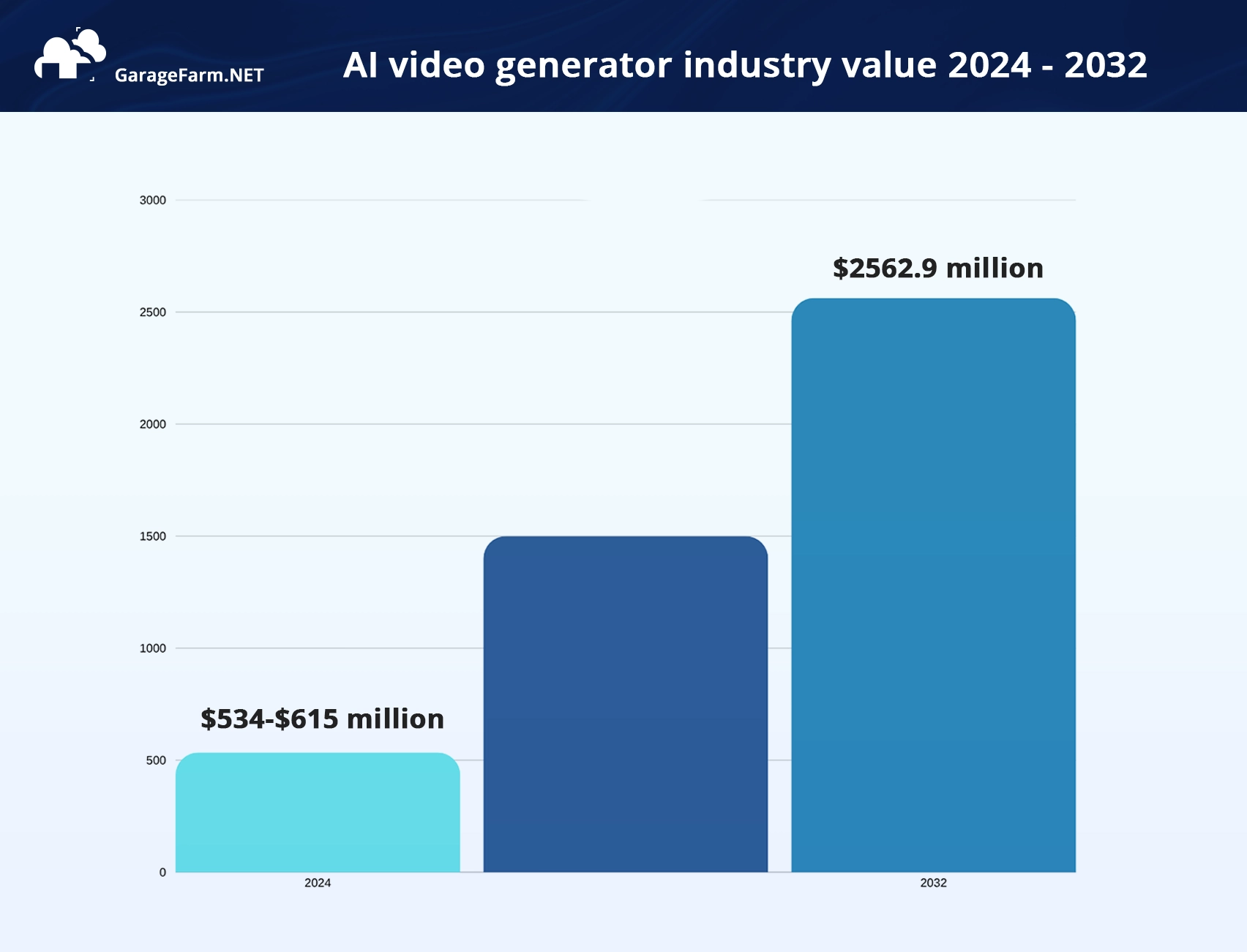
AI video generators are transforming content creation by making professional-quality video production faster, more affordable, and accessible to businesses of all sizes. With the market expected to grow from $534.4 million in 2024 to over $2562.9 million by 2032 according to Art Smart AI, these tools are becoming essential for marketing, education, and entertainment. While challenges around quality consistency and costs remain, the technology is rapidly maturing and reshaping how we think about video content creation.
AI video generators are systems built on generative artificial intelligence that convert text prompts, images, or video clips into fully realized moving images. The experience resembles writing a script for an invisible production team. Instead of hiring actors, setting up cameras, and managing an editor, you can describe the concept in plain language and let the AI generate it.

The foundation of these tools lies in machine learning, computer vision, and text-to-video models. Neural networks trained on millions of frames learn how motion, light, and perspective interact. Diffusion models gradually refine noisy images into coherent video sequences. Large language models help interpret natural language prompts with nuance, enabling creators to ask for not just “a cat on a couch” but “a Siamese cat stretching on a velvet couch in warm sunlight”. This video by Google Research sums up how text to video models work:
The AI video generator industry is scaling at remarkable speed. In 2024, its global market value was estimated at around $534 to $615 million. Projections suggest it will climb to $2562.9 million by 2032. North America holds around 40 percent of the market, but other regions such as Asia-Pacific is fastest-growing thanks to a tech-savvy population and widespread use of social media platforms. The growth is powered by demand for personalized content, the dominance of short-form video platforms like Instagram Reels and YouTube Shorts, and the need for businesses to produce more video at less cost.

The process starts with a prompt. A sentence or two is analyzed for subject, mood, setting, and style. In text-to-video generation, the model creates a sequence of frames from scratch, transforming words into motion. In image-to-video methods, a still picture is animated, such as giving a brand mascot the ability to wave and speak. Video-to-video techniques expand on or reimagine existing footage, useful for turning rough recordings into new and polished presentations. In this video by 3Blue1Brown and Welch Labs, we see how I videos actually work:
Fully generative models like OpenAI’s Sora or RunwayML’s Gen-4 allow for unrestrained creativity, producing entirely new videos based on a text prompt. Template-driven platforms such as Synthesia or Invideo AI offer structured frameworks where users can customize avatars, scripts, and designs for consistent branding. Marques Brownlee shows examples of OpenAI’s Sora and its many features and capabilities:
Sora demonstrates how far generative AI has come. In one demonstration, it produced a 1-minute sequence of a Tokyo street scene, complete with moving cars, glowing neon, and pedestrians crossing. The level of detail showed impressive handling of depth, motion, and design.
Synthesia has already become a staple in enterprise video creation. Fashion giant BESTSELLER used it to roll out a global training program across multiple languages. The company generated branded AI avatars that presented consistent information to employees worldwide. This reduced production time drastically, cut translation costs, and allowed updates to be rolled out quickly whenever procedures changed. Similar strategies are now being adopted for onboarding videos, investor updates, and company-wide announcements. In this video by Synthesia, we see how these AI avatar work and their potential in the corporate world:
AI video generators thrive in marketing, where eye-catching visuals drive engagement. They are equally effective in education, where multilingual explainers can be generated without the need for multiple filming sessions. Social media content creators use them to generate short, high-quality clips that stand out in crowded feeds. Product demonstrations and animated explainers are slowly becoming more doable with AI-powered video generation. This example by Affogato AI makes uses of AI to make a product ad video:
Marketers have been among the earliest adopters. According to eMarketer, nearly half of them (49%) now use AI video generation in their workflows. Enterprises are heavily investing in generative AI, and likely command a large share of revenue in AI video tools given their scale, though precise revenue dominance metrics are not publicly confirmed. Small businesses are catching up fast, as subscription models make these tools more affordable than ever.
According to Technollama, the global daily active users for generative AI is likely around 115 to 180 million people. Young audiences between 18 and 34 are the most responsive demographic, particularly on platforms like Instagram, YouTube, and TikTok. Business-to-business applications focus on structured communication, while business-to-consumer models emphasize entertainment, virality, and personalization.
AI video generators are available at multiple price points. Free tiers provide limited testing opportunities but often restrict resolution or watermark the output. Mid-tier subscriptions, typically priced between 10 to 50 USD per month, offer enough power for most small businesses and independent creators. Some enterprise plans can start from 100 USD monthly, offering expanded integrations.
The value lies not only in money saved but also in time where projects which once took weeks can now be completed in days or even hours. Compared to traditional video shoots, which involve equipment, crew, and editing, AI-powered workflows are leaner and faster. However, hidden costs exist, such as the need for additional editing, storage requirements, or training staff in prompt engineering. For companies with consistent video needs, the break-even point is reached quickly, making the investment worthwhile.
Physics remains one of the hardest problems for AI video models. Characters may walk without proper weight, and objects sometimes behave unnaturally. Keeping a character consistent across multiple clips is also a hurdle, with avatars sometimes shifting appearance. Complex camera moves can lead to jittery motion, and audiovisual synchronization requires manual correction to align sound effects or narration properly with visual actions.
Advanced tools can be expensive, and many of the most powerful models are locked behind enterprise pricing. Intellectual property concerns are growing, especially around copyright ownership of AI-generated content. Quality varies across outputs, which means human oversight remains essential. There are also risks of misuse, particularly in generating misleading or deceptive media, which has sparked debates around regulation and ethics.
Choosing the right platform depends on several factors. Video quality and resolution determine whether content is suitable for social media or professional presentations. Prompt adherence and creative control indicate how faithfully the AI interprets instructions. Integration with existing workflows, such as exporting to editing software or linking to social media accounts, is also critical. Finally, pricing must align with the expected frequency and scale of production.
Generative leaders like Sora, RunwayML, and Luma Dream Machine push the boundaries of creativity with freeform outputs. Business-focused platforms such as Synthesia, and Invideo prioritize structure and corporate communication. Platforms like Pika Labs excel at producing fast, viral-ready clips that can be useful for social media. For budget-conscious users, platforms like Canva AI offer a low barrier to entry while still delivering respectable results.
Industry voices emphasize that AI is not only a tool for automation but also for creative augmentation. Real-time generation is expected to become commonplace, where videos are created instantly during live collaboration sessions. Audio generation will advance alongside visuals, enabling seamless narration and sound design directly within the platform.
Custom AI avatars trained on a company’s branding will ensure consistent corporate identity. Synthetic influencers are likely to expand across Instagram and TikTok, raising questions about authenticity. Integration with marketing automation platforms will allow AI-generated content to flow directly into campaign pipelines.

Job opportunities in AI-powered content creation are expected to rise, especially by 2030. The market will likely see consolidation as major tech companies acquire smaller startups. Governments are beginning to explore regulation, especially around copyright, intellectual property, and terms of service for generated content. The next frontier is likely VR and AR, where AI-generated environments will blend seamlessly with immersive media.
The decision depends on scale, goals, and risk tolerance. A small startup focused on Instagram campaigns may benefit from an inexpensive subscription and quick outputs. A multinational enterprise may justify higher costs for consistency, localization, and integrations. Teams should consider their internal capabilities and decide whether training in prompt writing and video editing is necessary before fully committing.
Successful adoption begins with small experiments. Pilot projects help determine whether AI-generated videos align with branding needs. Blending AI outputs with human creative oversight ensures that the end product remains polished and trustworthy. Quality control processes should be in place to manage inconsistencies and ensure compliance with copyright law.
The easiest path is to explore free trials. Platforms like Sora and Invideo AI often provide browser-based onboarding, removing the need for complex installations. Training staff in prompt engineering improves the relevance of results, while integrating these tools with existing editing platforms ensures a smooth workflow. Measuring success through engagement rates, cost savings, and production time is also critical to assessing long-term value.